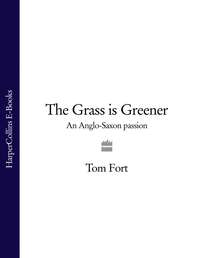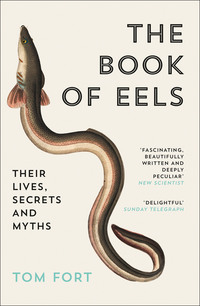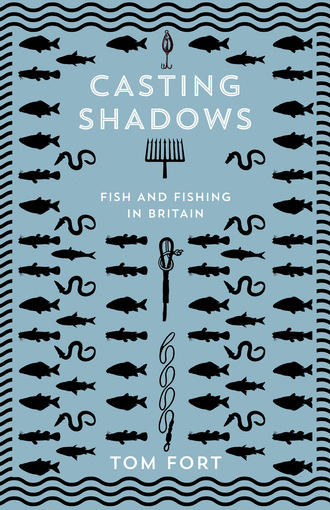
Полная версия
Casting Shadows
Amid familiar scenes expressing civic pride – bands playing, feasting, pompous speechifying – the canal was opened in 1817. For a time small vessels did use it to deliver and take on cargoes of timber, grain, coal and so forth. But Dingwall struggled to compete with other, more favoured ports. By the mid-1830s the harbour was taking no more than £130 a year in dues, not enough to pay to keep the canal in good repair and the ever-encroaching sands away from the mouth. No one wanted the job of Collector of Shore Dues, and despite an expensive refurbishment, which included removing silt from the canal and extending the harbour piers, the combination of the coming of the railway and the silting-up of the harbour mouth finished it off in the 1880s.
Dingwall’s efforts to improve itself had been a disappointment, and the failure of the canal was a heavy burden on the council’s finances. But not as heavy, nor as galling, as the fiasco over Dingwall’s salmon fishery.
The town slumbered in the half-light of a cool, overcast September morning. The road to the harbour passes the hospital and ends at a car park close to the Cromarty Firth. The area beyond has been grassed and landscaped for the benefit of dog walkers and lovers of the open air, although the closure of the footbridge over the defunct canal on safety grounds has severely truncated the Round Dingwall Walk promoted by the community council.
At low tide, the remnants of Dingwall’s disappointed maritime ambitions are very evident. Blackened posts rising from smooth grey mud mark what must have been the approach to the harbour from open water. The harbour wall itself is still sound, but what would have been a safe anchorage, even a port in a storm, is now filled high with fat mudbanks between which the meagre Peffery creeps towards the firth. When I was there two dirty, uncherished fibreglass dinghies lay on the slope of the mud nearest the wall, tethered by long greasy ropes.
I looked out across the firth to the fields of the Black Isle, richly dark where recently ploughed. The tide exposed flats of mud on the near and far sides. Between them the current of the River Conon pushed purposefully in the direction of the sea. This is one of the prime rivers of Highland Scotland, draining four hundred square miles of upland mountain terrain and moorland, gathering in tributaries great and small, its final few miles flowing through rich grazing and arable land.
On the mudflat in front of me there was a line of black, weedy rocks regular enough to suggest deliberate arrangement. This unexciting structure was what I had come to see. The line comprised deposits of stone placed to support or revet the alder stakes and willow panels that formed the Dingwall yair – yair being the Scottish term for a fish trap. Radiocarbon analysis of one of the eroded stumps revealed that it had been driven into position sometime in the second half of the seventeenth century.
The principles of the Dingwall yair are the same as for fish traps built by primitive and developing societies all over the world – a permanent structure arranged to intercept the passage of migrating or feeding fish in shallow water. In Scotland they were generally installed along the shallow, shelving edges of sea lochs and estuaries where they were covered and then made accessible by the fluctuations of the tides. The usual shape was a rough V, or that of a harp with one straight side and a longer curved one, and they were generally aligned to intercept fish on the ebbing tide. Fish would enter the wide mouth and would make their way along the walls of wattle panels without being aware that their space was being confined until they reached the apex, where they generally hit a net or entered a kind of holding basket from which there was no escape.
We know the Dingwall yair was in use 350 years ago, but it is a sure bet that a similar trap was working there or thereabouts for centuries and quite possibly millennia before that. The awareness of the movements of salmon – how they come in on the tide towards the river mouth then drop back on the ebb, the pattern repeated until there is a sufficient flow of fresh water to draw them upstream – is as old as time. The availability of construction materials for a trap – stones, posts, withies – presented no difficulty. And until modern times the abundance of salmon was such that even this primitive technology, if in the right place, could justify the effort required to maintain it.
But not all yairs were equally effective, and the history of the Dingwall yair, chronicled briefly and spasmodically in the records of the town council, shows that the effort was considerable, and, as time went on, increasingly regarded as not worthwhile. The first mention of the yair is dated 1732. One William Fraser proposed that its condition ‘having been ruinous for several years’, he would rebuild and maintain it. The tack, or rental, was awarded to him for ten years, but no charge was made, presumably because the yair was in such a state of dereliction.
It is not known how William Fraser fared with it, but thirty years later he – or one of the same name – had other fish to fry. He proposed to the council a five-year lease ‘of a coble fishing’ at a yearly rent of sixty marks, but on condition that the council lend him one hundred marks ‘to set up the fishing’. A coble was an open boat, and coble fishing involved shooting a net several hundred feet long from its stern while it was rowed in a semi-circle, the two ends then being gathered and pulled together by a tow-rope either from the shore or another boat. It is also an ancient method, highly efficient (and still in use today), but obviously more labour intensive and therefore expensive. The way the Dingwall minute is worded suggests that a net-and-coble operation was a novel concept; all the councillors asked for in return was that Mr Fraser should ‘furnish and sell to the inhabitants … preferable to all others as much salmon as the said inhabitants will have occasion for during the fishing season at one penny for each pound’. Had they any inkling of the trouble they were storing up for their successors, they might have debated William Fraser’s offer more thoroughly.
Two years later someone, possibly Mr Fraser, was evidently trying to keep the yair in business, as the council accepted a supply of alder wood cut by Alexander MacKenzie ‘for wattling to the yair … and stakes to the said yair’. But its fortunes clearly slumped, as in December 1791 the use of it, ‘which has remained unoccupied for some years past’, was snapped up by Mr John Simson at a yearly rent of one pound eleven shillings and sixpence on condition that he ‘shall build and erect a sufficient yair’. The value was clearly going in one direction, down, as six years later ‘Mr Patrick Hay, merchant’ secured it at eight shillings per annum on the same condition as Mr Simson.
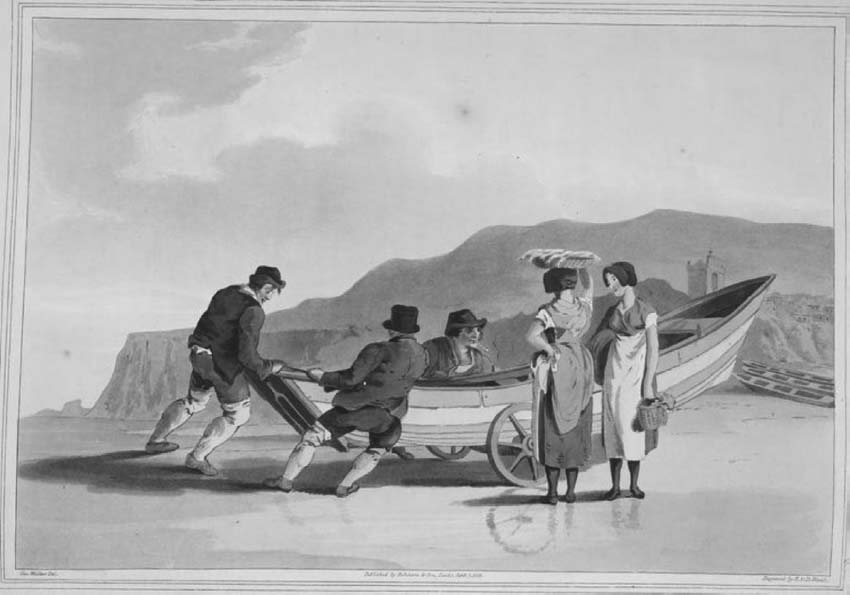
A traditional Yorkshire coble being pulled up from the sea in the early 1800s.
The Costume of Yorkshire, illustrated by a series of forty engravings, published by T. Bensley in London in 1814. Sourced from Archive.org
By then the focus had clearly switched from the old and generally unproductive yair to the far greater economic value of net fishing. In the same year that Mr Hay forked out a few shillings to rent the trap, the council agreed to rent the ‘stell fishings belonging to the Burgh’ to Forbes and Co. of Aberdeen at £25 a year, on the condition that they would provide salmon for the locals at preferential prices.
The term ‘stell’ – derived from the word for a sheep enclosure – simply meant fishing rights. In 1813 the council reached a deal with a Berwick-upon-Tweed businessman, Mr Landles, for him to rent the fishery at the same rate as Forbes and Co., but with a lump sum of £860 added; he also got the yair thrown in for an extra £20 a year. Mr Landles also agreed to provide cut-price salmon to the town, and the good burghers must have congratulated themselves on their canny management of the resource on their doorstep: a steady income in return for no expenditure or effort, and cheap salmon steaks to boot. But six years later an ominous note was sounded in the minutes with a passing reference to ‘a dispute having arisen between the Tacksmen of the Town’s Stell Fishings and the Tacksman of Culcairn’s Fishings with regard to the extent of the respective rights of parties …’
In fact the argument over who had the right to catch the salmon of the Conon – and by extension, over whom the salmon arriving from the seas off Greenland actually belonged to – had by then been rumbling along in the background for almost a century, since the Earl of Cromarty had attempted to take ‘by violent possession’ fishing held by Munro of Culcairn. The magistrates of Dingwall (appointed by the council) maintained that they exercised the right to fish by royal charter granted by James VI in 1587, confirming two earlier charters from 1497 and 1226. But in 1825 Mrs Anne Hay-Mackenzie of Cromarty brought an action against Dingwall’s magistrates claiming that she and her tenants had sole rights to the lower section of the river. The complications of the case were enormous and it took the Court of Session seven years to find in favour of the rich and powerful Mrs Hay-Mackenzie, and against the town of Dingwall.
At this point in a protracted and tedious legal saga, the magistrates of Dingwall made a fateful decision. Instead of retreating to lick their wounds and pondering the maxim that standing up to the bigwigs almost never pays, they resolved to fight on. In the words of Dingwall’s historian, Norman Macrae, they ‘foolishly – may I not say inexcusably – appealed this decision to the House of Lords’.
The appeal was dismissed and further litigation was embarked upon, while the council continued to let the fishing, and even tried to sell it outright. All the time the legal bills mounted. By 1850 they exceeded £3,000 and Dingwall council did not have the means to pay. The repayments were strung out over many years, a heavy burden on a town that had never been wealthy, while the Mackenzies and their tenants helped themselves to the salmon. Of Dingwall’s age-old yair, nothing more was heard. Like the harbour, it rotted away until nothing more than the stumps or the old posts and the stones used to fix them were left for the tides to wash over and the salmon to swim past.
No other fish – with the possible exception of the rare and freakish sturgeon – was as sought-after for the banquets of the rich and powerful as the salmon. Being able to offer it to prestigious guests was, of itself, a mark of high standing. When the mute monks at the great Burgundian monastery of Cluny required salmon, the sign they used connoted both pride and the fact that they were used to such fare. Ninth-century documents from Prüm Abbey in Germany show that the abbot had rights to take salmon from the Rhine and the Moselle for the monks’ feasts.
But as early as the thirteenth century the runs of salmon into the rivers of France and Germany were in decline as a result of overfishing, the installation of mills and other barriers to migration, and changes in land use. No such problems were encountered in Scotland, which increasingly assumed the role of major exporter of salmon to the rest of Europe. Power in Scotland lay with its kings, and below them with the lay lords and religious houses, and at each level a surprisingly tight grip on the exploitation of salmon was exercised. Successive Scottish kings asserted their control over the major rivers and granted rights to take salmon from them – initially the Tweed, Forth, Don, Tay, Spey and North Esk, subsequently others including the Ness, Border Esk and Leven.
Often these rights were split between the secular and religious sectors. The Cistercian monastery of Coupar Angus, north of Perth, had extensive fishings on the Tay nearby, but also on the Deveron, North Esk and Ericht. Monastery records from 1508 refer to the pool at Stanley on the Tay as being ideal for the use of a seine net. Naturally enough the monks did not haul the nets themselves, and the fishing was usually let to tenants who were licensed to sell a portion of their catch on condition that the best of it went to the monastery. On the Ericht, Thomas de Camera was obliged to provide eighty salmon a year as part of his rental agreement.
Where the river was suitably wide and the flow not too fierce, nets were used. But in the narrow channels and the necks of pools, the preferred method was to install a cruive, a rectangular, box-shaped trap held in place by stone dykes. The Black Friars of Inverness were granted fishing rights on the Ness by Alexander II in 1240; subsequently they devolved to the town’s Burgh Court and to Lord Huntley, who controlled the fishery below the castle.
The channels between the islands on the Ness were ideal for the use of cruives; a map of 1744 entitled ‘Views of the Cruives’ shows multiple installations through the town. The salmon trade was important and poaching from the traps was a serious offence. In 1559 Donald Yet was sentenced to have his ear nailed to a beam in the marketplace for nine hours after he was caught filching six salmon from one cruive. John Crom (Bent John) fared even worse for a similar crime – he was left to tear his ear from the nail.
The international trade in pickled and salted salmon packed in barrels developed from the late fourteenth century onwards. In 1426, for instance, eight thousand fish were shipped out of Aberdeen. Some went to London, some to the ports of Hull and Kings Lynn en route for the Continent. It was a lucrative small-scale trade: a barrel retailed at thirty to fifty shillings, with a tax of a penny per fish going to the Crown.
The authorities in Scotland were alive to the importance of their salmon fisheries, and the need to conserve and protect the stock. In the thirteenth century William I, known after his death as ‘the Lion’ but nicknamed ‘the Rough’ during his lifetime, ordered that all weirs on Scottish rivers – used to divert salmon into traps – should have a permanent mid-stream gap ‘so large that a well-fed three-year-old pig should turn about without touching its tail or snout’ so that a portion of the run would be sure to get through. They were sufficiently familiar with the salmon’s life cycle to know how crucial it was to ensure the safe passage of smolts downriver – hence the statute of 1318 prescribing a three-by-two-inch minimum mesh size for nets. Fishing was not allowed between Saturday evening vespers and dawn on Monday, and a close season of varying length was enforced, with exceptions, to let the late-spawning fish through.
The eminent Canadian historian of pre-modern European fishing and husbandry, Richard Hoffmann, labelled the various Scottish statutes protecting the salmon as an example of ‘precocious state intervention’ – even a precursor to the European Union’s Water Framework Directive. It reflected an acute awareness of both the economic value of the fish, and the need to look after it at crucial stages of its cycle. With that awareness came jealous guardianship that – because of the extended nature of the salmon’s journey, necessarily taking it past the properties of multiple landowners – inevitably led to the kind of dispute that bankrupted poor Dingwall.
The chronicles of Scottish history are littered with accounts of quarrels and lawsuits between the owners of land on major rivers. Many centred on fishing and the taking of salmon at one point on the migratory route, thus preventing them from reaching the next. The exploitation of water power for emerging cottage industries created a new bone of potential conflict.
In 1755 long-standing rivalry between two branches of Clan Campbell based at Ormidale and Glendaruel near the Kyle of Bute erupted into a notorious pitched battle in and beside the River Ruel. Campbell of Glendaruel’s jealousy of his cousin at Ormidale was intensified when the latter installed a weir and dam to power the wheel of a mill used to dress cloth produced by local weavers. Glendaruel asserted that the dam was blocking the passage of salmon to his stretch of river, and sent men in the night to breach it. Ormidale had it repaired under a hail of stones from his cousin’s retainers. It was breached again, repaired again. Then Glendaruel sent this stirringly worded challenge: ‘Sir, I will have no more child’s play … I will bring one hundred men and you will bring the same, otherwise you are a coward and devoid of honour … I will drown you and all your unspirited men in your dam and make your bodies food for the fishes.’
Next morning the horn was sounded along the glen and both chieftains led their men, armed with cudgels, into the water by the dam where they set about each other with vigour until the Reverend Mr Forbes, the minister from the nearby village of Clachan, intervened to implore the parties to separate in the name of God. No one was killed, but there was a fine display of cuts and bruises. Eventually the dispute was resolved in court, with Ormidale undertaking to put in a fish-ladder so that the salmon could ascend the dam in high water.
The foreshore at Sudbrook Point, in the shadow of the bridge that takes the M4 into Wales, is – like the car park at Dingwall harbour – a mundane location from which to consider the distant history of fish exploitation. The village of Sudbrook was built to house workers hired to dig the Severn railway tunnel in the 1870s and 1880s, and is still dominated by the redbrick bulk of the pumping station in which the six engines needed to suck the water out of the tunnel were housed. A path leads from a car park past a football pitch to the top of a low, much-eroded sandstone cliff from which the intimidating vastness of the Severn estuary stretches towards a distant, indistinguishable England.
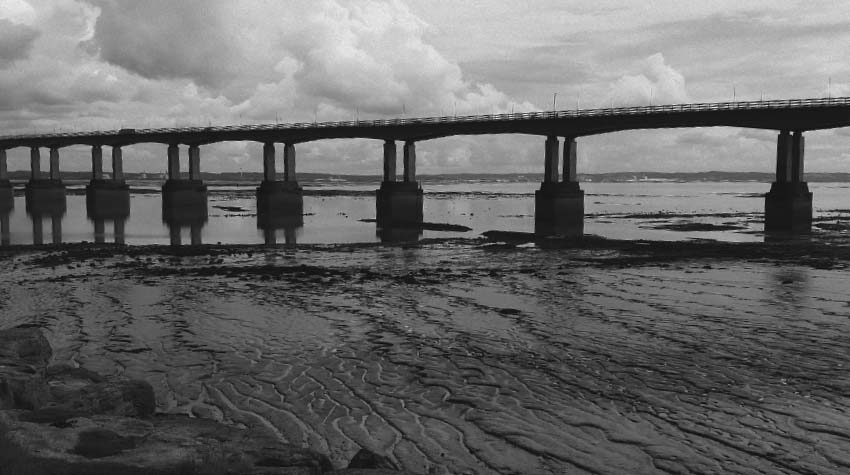
Severn Bridge at Sudbrook Point.
Tom Fort
I timed my visit to coincide with a low spring tide. The bridge was going about its noisy, monotonous business high in the air, infinitely divorced from the intricately sculpted world of water, rock, mud and sand below. Downstream, partially visible through the arches, was Avonmouth Docks. The grey sky spread over distant clusters of wind turbines, standing like sentinels, their blades motionless on this still afternoon.
The liquid component of the estuary was wonderfully reduced, allowing the mudbanks and sandbanks to reveal themselves like lost kingdoms. The water in the web of channels was glass-like, going nowhere, untouched by current or wind. Immediately below me the mud extended a hundred yards or so from the stony beach. Its surface was like skin seen under a microscope, grooved by complicated networks of tiny runnels and studded with black, greasy rocks. I would not have wished to take a step anywhere on it, yet long ago men who knew what they were doing ventured forth securely on it to gather food to eat and trade.
In January 2007 an unusually potent winter storm combined with exceptionally strong tidal currents to sweep away a layer of long-established sediment from the shore at Sudbrook Point. Across the country trees were uprooted, lorries were sent skidding off roads and trains ground to a standstill. At least nine people were killed and millions suffered transport delays, power cuts and general inconvenience. But for archaeologists interested in ancient fish traps, the cleansing of Sudbrook Point was an extraordinary stroke of luck.
Exposed at the surface of the mud were the upper parts of an array of fish-trap components in a remarkable state of preservation despite being, in some cases, almost a thousand years old. They included stakes, hurdles, a withy tie and – most precious of all – sixteen baskets or parts of baskets woven from hazel and willow. Having taken measurements and tiny samples for radiocarbon analysis, the archaeologists judged that the baskets would have made up one or more of the traps known as putts, a Severn speciality in which three baskets of varying sizes are fitted together as one, with the prey – anything from a salmon to a shrimp – detained in the innermost and smallest one, known as the forewheel, which had a wooden stopper so nothing could escape.
It is thought that this was an example of the trap referred to in Anglo-Saxon charters as cytweras. It was the Severn way to fix them in ranks three or four deep and thirty or more wide, each trap being five or six feet in diameter at the open end, and twelve to fourteen feet long. Generally they were fixed facing upstream to take fish on the ebb tide, and they presented formidable barriers. Putts and their smaller, simpler relatives known as putchers were mentioned in legislation in the sixteenth century and were referred to as ‘ancient fisheries’ in a parliamentary Act of 1778. They continued in use until very recently – indeed until the runs of salmon declined to such a point that the Environment Agency in effect closed the Severn fishery down.
Also found in the mud at Sudbrook Point were three much smaller and more closely woven baskets – one with an integral throat, which prevented captured fish getting out. These were probably eel traps, which would have been baited – perhaps with a tasty bit of fresh rabbit or offcuts of salmon – weighted with stones and laid in the river with a tether to the shore. Traps of a similar conical design were staked out in shallower channels to catch that much-appreciated delicacy, the lamprey.
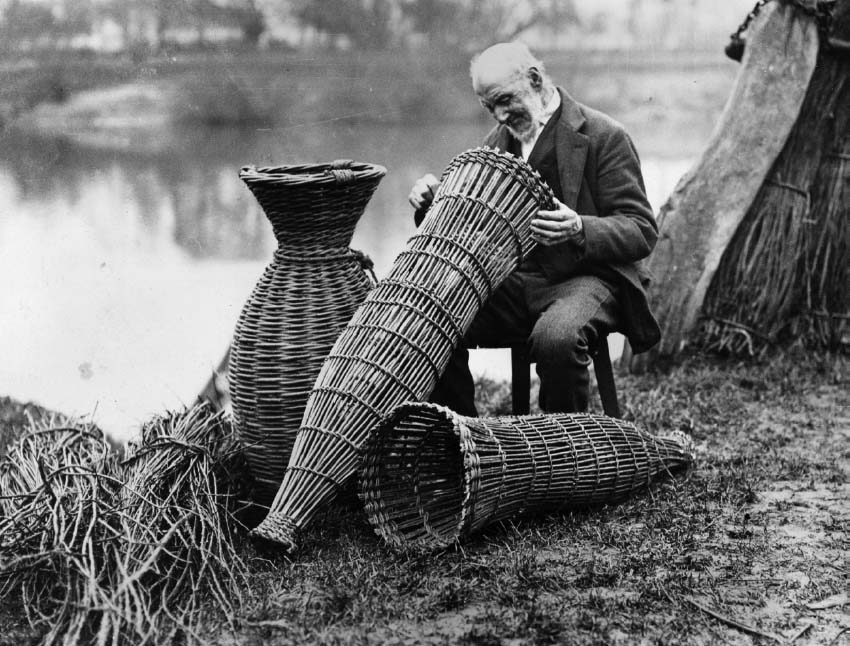
An old Severn fisherman making conical willow putchers, used for catching salmon and eels, 1932.
Fox Photos/Getty Images
The finds at Sudbrook Point were all the more delightfully unexpected because the area had been extensively surveyed by archaeologists sixteen years earlier in advance of the building of the bridge. That study uncovered the remains of fish traps in sixteen places – including post-settings, hurdle panels and fragments of baskets dating from the eleventh and twelfth centuries. Remnants of a similar kind were found a little way up the same shore at Magor Pill. The oldest yet found in Britain was located a few miles downstream at Cold Harbour Pill, where a section of Bronze Age fence and a bit of what may have been a basket were recovered.
Pretty much wherever archaeologists have poked around on both sides of the estuarial Severn, they have found the remains of fish traps. Investigations on other estuaries all over Britain and Ireland reveal a matching picture. In the Anglo-Saxon era the mudbanks of the Blackwater estuary in Essex were lined with V-shaped fish weirs, some with walls three hundred metres long. The shores of Strangford Lough in Northern Ireland have yielded evidence of numerous fish traps of the standard design dating from between the eighth and thirteenth centuries, which caught salmon and eels as well as various sea fish, including cod and skate. On the Shannon estuary in south-west Ireland, surveys revealed multiple traps, generally smaller than those in Essex, with walls thirty to forty metres long.
The exploitation of the freshwater fish resource took place in every suitable location. In general the fragmentary surviving records merely note who owned those locations, while revealing little or nothing about those who did the work and formed those fishing communities. An exception is the documentation from the two great estates of Berkeley and Thornbury that controlled the land and shorelines along the eastern, English side of the Severn estuary. This does furnish fragmentary glimpses of that artisan fishing dimension at a local and even individual level. In 1255 Peter de Wike is recorded as leasing the fishery at Berkeley Pill – now the site of Berkeley power station – from St Augustine’s Priory in Bristol, although by 1370 this had been taken over by the Berkeleys of Berkeley Castle. In 1594 an educated lawyer, John Smyth, became steward to the Berkeleys and made it his business to study the deeds and papers accumulated since the twelfth century.




